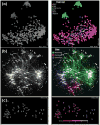Unlocking the potential of metagenomics through replicated experimental design
- PMID: 22678395
- PMCID: PMC4902277
- DOI: 10.1038/nbt.2235
Unlocking the potential of metagenomics through replicated experimental design
Abstract
Metagenomics holds enormous promise for discovering novel enzymes and organisms that are biomarkers or drivers of processes relevant to disease, industry and the environment. In the past two years, we have seen a paradigm shift in metagenomics to the application of cross-sectional and longitudinal studies enabled by advances in DNA sequencing and high-performance computing. These technologies now make it possible to broadly assess microbial diversity and function, allowing systematic investigation of the largely unexplored frontier of microbial life. To achieve this aim, the global scientific community must collaborate and agree upon common objectives and data standards to enable comparative research across the Earth's microbiome. Improvements in comparability of data will facilitate the study of biotechnologically relevant processes, such as bioprospecting for new glycoside hydrolases or identifying novel energy sources.
Figures


Similar articles
-
Practical considerations for sampling and data analysis in contemporary metagenomics-based environmental studies.J Microbiol Methods. 2018 Nov;154:14-18. doi: 10.1016/j.mimet.2018.09.020. Epub 2018 Oct 1. J Microbiol Methods. 2018. PMID: 30287354 Review.
-
Marine Metagenome as A Resource for Novel Enzymes.Genomics Proteomics Bioinformatics. 2015 Oct;13(5):290-5. doi: 10.1016/j.gpb.2015.10.001. Epub 2015 Nov 10. Genomics Proteomics Bioinformatics. 2015. PMID: 26563467 Free PMC article. Review.
-
MetCap: a bioinformatics probe design pipeline for large-scale targeted metagenomics.BMC Bioinformatics. 2015 Feb 28;16(1):65. doi: 10.1186/s12859-015-0501-8. BMC Bioinformatics. 2015. PMID: 25880302 Free PMC article.
-
Interrogating the microbiome: experimental and computational considerations in support of study reproducibility.Drug Discov Today. 2018 Sep;23(9):1644-1657. doi: 10.1016/j.drudis.2018.06.005. Epub 2018 Jun 8. Drug Discov Today. 2018. PMID: 29890228 Review.
-
Quantitative Assessment of Shotgun Metagenomics and 16S rDNA Amplicon Sequencing in the Study of Human Gut Microbiome.OMICS. 2018 Apr;22(4):248-254. doi: 10.1089/omi.2018.0013. OMICS. 2018. PMID: 29652573
Cited by
-
Emerging concepts promising new horizons for marine biodiscovery and synthetic biology.Mar Drugs. 2015 May 13;13(5):2924-54. doi: 10.3390/md13052924. Mar Drugs. 2015. PMID: 25984990 Free PMC article. Review.
-
High-throughput DNA sequencing technologies for water and wastewater analysis.Sci Prog. 2019 Dec;102(4):351-376. doi: 10.1177/0036850419881855. Epub 2019 Oct 15. Sci Prog. 2019. PMID: 31818206 Free PMC article. Review.
-
Interplay between autotrophic and heterotrophic prokaryotic metabolism in the bathypelagic realm revealed by metatranscriptomic analyses.Microbiome. 2023 Nov 4;11(1):239. doi: 10.1186/s40168-023-01688-7. Microbiome. 2023. PMID: 37925458 Free PMC article.
-
Shotgun metagenomics, from sampling to analysis.Nat Biotechnol. 2017 Sep 12;35(9):833-844. doi: 10.1038/nbt.3935. Nat Biotechnol. 2017. PMID: 28898207 Review.
-
Implications of the human microbiome project for epidemiology.Am J Epidemiol. 2013 Feb 1;177(3):197-201. doi: 10.1093/aje/kws449. Epub 2013 Jan 7. Am J Epidemiol. 2013. PMID: 23296358 Free PMC article.
References
-
- Falkowski PG, Fenchel T, Delong EF. The microbial engines that drive Earth’s biogeochemical cycles. Science. 2008;320:1034–1039. - PubMed
-
- Fisher RA. The Design of Experiments. 1935
-
- Gilbert JA, et al. In: Bioprospecting using metgaenomics. Himmel M, editor. Springer; 2011.

